Abstract
We develop a four-dimensional nonlinear model of a reflexive financial system by extending the Xin–Zhang system with a self-reinforcing sentiment channel. The model comprises four interacting variables—interest rate, investment demand, price index, and market confidence—and incorporates reflexivity to capture feedback between economic fundamentals and investor sentiment. A Lyapunov function shows that the system is well-posed and dissipative, ensuring bounded trajectories. We then analyse the dynamics using standard nonlinear-dynamics tools. Reflexive confidence sustains chaotic motion, inhibits convergence to equilibria, and produces irregular, aperiodic bifurcation patterns; sentiment-driven feedback destabilises a dissipative macroeconomic model and sustains volatility, as evidenced by a positive largest Lyapunov exponent and Kolmogorov–Sinai entropy greater than zero. Using U.S. monthly consumer sentiment and the S&P 500, we observe co-movement, a medium-horizon lead of sentiment, and a nonlinear persistence map —stylised facts consistent with the model’s self-reinforcing confidence channel.
Keywords:
chaotic financial system; reflexivity; market sentiment; Lyapunov exponents; nonlinear dynamics; fractal attractors; equilibrium stability; behavioural macroeconomics PACS:
05.45.-a; 05.45.Gg; 89.65.Gh
MSC:
37D45; 91B74; 37G15; 93D20
JEL Classification:
C63; E44; D84
1. Introduction
Chaotic systems are nonlinear dynamical systems that exhibit extreme sensitivity to initial conditions, leading to complex and unpredictable long-term behaviour. Such systems arise in diverse fields, including weather prediction, engineering, biology, and finance. In economic contexts, understanding chaotic dynamics is vital for analysing instability, improving forecasting, and guiding risk management strategies. This has motivated a substantial literature on nonlinear and chaotic dynamics in economics and finance [,,]. In continuous-time, low-dimensional ODE models of financial variables (interest rate, investment, prices) already display rich nonlinear behaviour. For broader context on chaos in economic models—including discrete time and implicitly defined frameworks—see [,,].
Market confidence is crucial in financial systems as it affects how people invest and spend. It stands for the confidence that consumers and investors have in the state of the economy. More investment and economic growth happen when confidence is high, which is frequently the result of low interest rates. Conversely, low confidence, which can result from high interest rates or economic uncertainty, may reduce investment and increase unemployment. Consumer spending is influenced by spending confidence, which is linked to investment confidence. Understanding and modelling these factors helps create better strategies to strengthen market stability and resilience.
The widely studied 3D Ma–Chen system provides a classical basis for modelling macroeconomic instability through the interaction of interest rate (x), investment demand (y), and price index (z) [,]. 4D Xin–Zhang system extends this framework by introducing market confidence (w) as a fourth state variable [], but in the context of a fractional-order formulation. Their system captures the influence of market sentiment on macroeconomic variables through the coupling terms , , and , but does not account for the self-reinforcing nature of confidence.
The 4D market confidence system is formulated as follows:
Here, a, b, and c are non-negative constants representing the amount saved, cost per investment, and demand elasticity, respectively. The parameters , , and quantify the effect of confidence on the system.
The concept of reflexivity in financial markets, originally proposed by George Soros [], emphasises the bidirectional relationship between market participants’ perceptions and actual market outcomes. According to this theory, investor beliefs influence economic fundamentals through actions such as buying, selling, or investing, which in turn shape those same beliefs—a self-reinforcing feedback loop. This contrasts with traditional economic models that assume markets operate under rational expectations and equilibrium conditions. Reflexivity captures the behavioural and psychological mechanisms by which sentiment amplifies booms or accelerates downturns, and is particularly relevant during periods of uncertainty and volatility. Despite its conceptual importance, reflexivity has remained difficult to formalise mathematically, especially in the context of nonlinear dynamical systems.
Formalizations of reflexivity and self-exciting feedback in markets include Hawkes-process reflexivity, belief-driven credit cycles, and self-referential expectations [,,]. While these models reflect key aspects of reflexivity, they are either stochastic or equilibrium-based and do not feature deterministic chaos, Lyapunov instability, or strange attractors.
Prior studies discuss reflexivity largely in empirical or agent-based settings; here, we present a compact deterministic ODE formulation with an explicit sentiment state and verify low-dimensional chaos [,]. This formulation allows us to investigate how sentiment-driven feedback loops can generate and sustain chaos in macroeconomic dynamics.
Section 2 develops the model: formulation, behavioural assumptions, and well-posedness/dissipativity analysis. Section 3 presents the results: chaos diagnostics (largest Lyapunov exponent, spectra, and embeddings), equilibrium stability, state trajectories, phase portraits, and bifurcation scans. Section 4 discusses implications for reflexivity-driven instability and interpretation within behavioural macro-finance. Section 5 concludes with policy and control takeaways and directions for future work.
2. Materials and Methods
2.1. Model Formulation
Motivated by Soros’s concept of a self-reinforcing feedback loop in market sentiment [], we propose an integer-order extension of the Xin–Zhang system that incorporates a reflexive self-feedback term in the w-equation. This captures the behavioural insight that confidence is not only influenced by economic variables but also self-reinforces via feedback from market sentiment itself. The addition of this term enables the system to sustain higher levels of volatility and richer chaotic dynamics. Our proposed extended model becomes
The model couples interest x, investment y, prices z, and reflexive confidence w. High x imposes a quadratic halt on y; z cools when x is high and lifts with w; and w self-reinforces but is suppressed when are jointly large. These feedbacks generate oscillatory, bursty motion.
- Interest rate x. Responds to inflation pressure z and to whether investment y exceeds a savings threshold a; larger tends to raise x.
- Investment demand y. Increases with confidence w but is suppressed by tighter rates via the term .
- Price index z. Decreases when x is high and can rise with w through spending pressure.
- Market confidence w. Reflexive through ; large simultaneous activate the brake .
Table 1 presents suggested ranges for the model parameters based on established economic reasoning and prior studies on chaotic financial systems [,,]. These values are selected to reflect realistic financial behaviours such as savings thresholds, investment sensitivity, price adjustment inertia, and the nonlinear influence of market confidence on system dynamics.

Table 1.
Suggested parameter ranges based on economic intuition.
2.2. Model Assumptions
The structure of the proposed model is based on several behavioural macroeconomic assumptions that describe how market confidence interacts with key financial variables:
- Interest rate and confidence: Market confidence tends to rise with accommodative monetary conditions, while tighter rates depress sentiment [,].
- Investment demand and confidence: Confidence and investment reinforce each other—optimism boosts investment plans; low confidence/uncertainty curbs them [,].
- Price index and confidence: Higher inflation erodes confidence and perceived purchasing power; strong sentiment can add demand pressure to prices [,].
- Nonlinear suppression effect: Following the Xin–Zhang system, confidence growth is damped when interest, investment, and prices are simultaneously high; we retain the multiplicative brake [].
- Reflexive feedback (novel): Confidence is self-reinforcing—improved outcomes bolster optimism—consistent with reflexivity and financial-instability views [,].
These assumptions collectively capture the dynamic interdependencies among economic variables and allow the model to reflect both stabilising and destabilising forces within a financial system.
The choice of parameter range for is guided by the dynamics of the w-equation:
The term acts as a nonlinear damping effect when x, y, and z are positive, while provides linear self-reinforcing growth of market confidence. For small , damping can offset growth, keeping w bounded. If is sufficiently large, the growth term dominates over most of the trajectory, and the equation reduces to , yielding exponential divergence. Because w also appears in the x-, y-, and z-equations, such growth destabilises the entire system. This mechanism imposes a practical upper limit on for bounded chaotic behaviour, and we restrict simulations to values below this threshold.
2.3. Well-Posedness and Positivity Analysis
2.3.1. Well-Posedness
We consider the extended financial system defined by (2) where and the parameters are real constants with .
Each right-hand side is a continuously differentiable function of , and thus locally Lipschitz in . By the Picard–Lindelöf theorem, the system admits a unique local solution for any initial condition in . Hence, the system is locally well-posed.
To investigate global existence, we define the Lyapunov function:
Note that this function satisfies the standard properties:
- Positive definite: for all .
- Radially unbounded: as .
The time derivative of V along system trajectories is
which expands to the polynomial in :
Observe that the leading quadratic terms , , and contribute negatively to and thus act as stabilising components in the system.
To control the growth of positive mixed terms , , and , we can apply Young’s inequality:
For example, the term satisfies
Applying Young’s inequality to the bilinear terms and noting that the trajectories we study remain in the non-negative orthant, so that , we obtain the bound
Hence,
Here, are small constants chosen to balance the mixed terms using Young’s inequality.
Choosing sufficiently small ensures that the negative quadratic terms dominate; hence for some constants and . This implies the trajectories are ultimately bounded, confirming the system is dissipative. When the parameters , particularly , are sufficiently small, the system exhibits dissipativity, and remains bounded for all t. This implies that all trajectories are ultimately bounded and the system is globally well-posed in this parameter regime.
2.3.2. Positivity
For economic interpretation, it is desirable that (interest rate, investment demand, price index, market confidence) remain non-negative. The system, however, does not guarantee positivity preservation for all parameter choices: on the boundaries and , the vector field is inward (, ), whereas at or , the signs of and depend on and parameters . Hence the non-negative orthant is not invariant in general. In our simulations, we restrict parameters and initial conditions so that all state variables remain non-negative over the reported horizons; we do not claim global positivity invariance.
2.3.3. Diagnostics Used
Chaotic dynamics. We use “chaotic” to denote trajectories with sensitive dependence on initial conditions. Operationally, chaos is evidenced by a positive largest Lyapunov exponent , so that small perturbations grow on average as
(Classical topological criteria involve mixing and dense periodic orbits; for numerical studies, is the standard indicator; see, e.g., [,].)
- Lyapunov exponents. For the smooth autonomous system with flow , the Lyapunov spectrum quantifies mean exponential growth/decay rates of infinitesimal perturbations along an orbit (Oseledets theorem). The largest exponent is
- Kaplan–Yorke (Lyapunov) dimension. Let and choose j as the largest index with . The Kaplan–Yorke (Lyapunov) dimension [] is
- Delay-embedding. Given a scalar observable , we reconstruct the state via delay vectors
3. Results
In this section, we adopt the baseline parameter values from the Xin–Zhang system (1) as follows:
where is the additional parameter introduced in our extended model to capture the self-reinforcing feedback loop in market confidence.
For dynamic simulations, we restricted the sweep of to the interval (see Section 2.2) to avoid finite-time blow-up and to ensure well-posedness (see Section 2.3.1). Unless stated otherwise, we restrict parameter scans to empirically feasible ranges identified from the peak–scan diagnostics reported in Appendix A (Table A1; see also Figure A1 and Figure A2). Fixed initial conditions are , , , and .
All simulations were performed in MATLAB R2019a using ode45 with RelTol and AbsTol. Unless otherwise stated, the output time step was , the time horizon was , and the transient discard was . The Benettin–Wolf algorithm [] was used to compute Lyapunov spectra, with re-orthonormalization interval and initial perturbation .
3.1. Chaotic Diagnostics at the Baseline Parameter Set
To verify chaos under the baseline parameters, we combined four complementary tests: the largest Lyapunov exponent (LLE), a frequency-domain check, a Poincaré section, and a nearby-trajectory divergence test. The finite-time LLE converges to a small but positive value, (Figure 1); this implies an e-folding time and a doubling time time units, indicating weak but sustained sensitive dependence. The post-transient power spectrum is broadband rather than a few sharp lines (Figure 2), inconsistent with purely periodic or quasi-periodic motion. Poincaré sections form dispersed, multi-strip sets instead of closed curves (Figure 3), and the distance between two trajectories beginning apart grows irregularly before saturating on the attractor (Figure 4). These diagnostics consistently support a strange attractor with slow exponential separation (“weak chaos”) in this parameter regime.
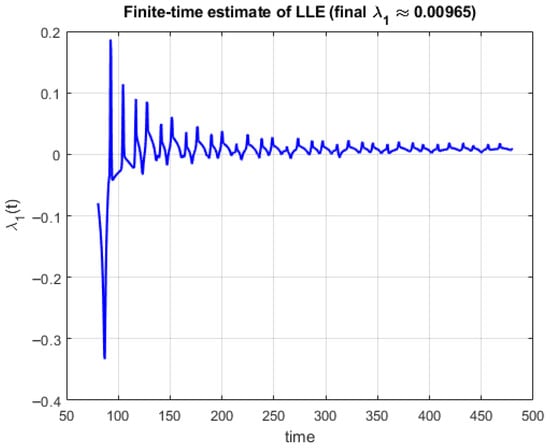
Figure 1.
Finite-time largest Lyapunov exponent estimate converging to .

Figure 2.
Power spectrum of (post-transient) showing a broadband continuum characteristic of aperiodic/chaotic dynamics.
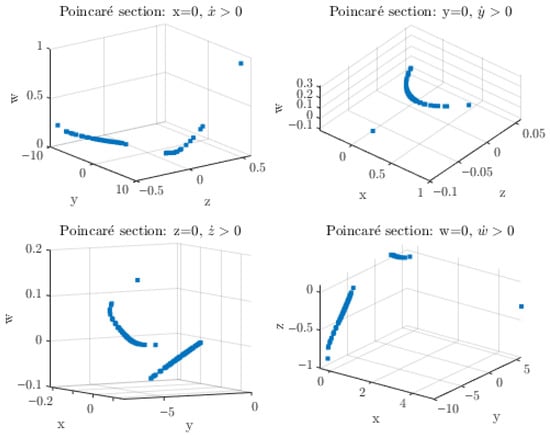
Figure 3.
Poincaré sections. The scattered multistrip set is incompatible with a single periodic orbit.

Figure 4.
Sensitive dependence: growth and eventual saturation of the separations , , , and between two trajectories started apart.
3.2. Lyapunov Exponent Spectrum Analysis
To examine the dynamical behaviour, we compute the full Lyapunov spectrum using the Benettin orthonormalization scheme and the Wolf et al. algorithm [,,].
Figure 5 and Figure 6 present the Lyapunov exponents as the feedback parameters , and the original system parameters are varied. Across all parameter scans, we observed, at most, one positive Lyapunov exponent; whenever chaos appears, the spectrum takes the canonical autonomous-flow form , with modest but nonzero, i.e., one expanding, one neutral, and two contracting directions—indicating chaos.
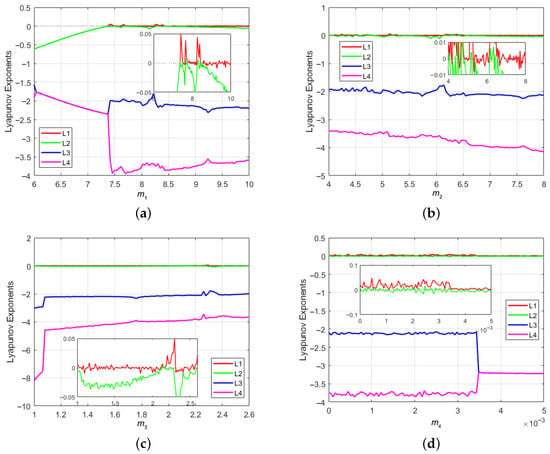
Figure 5.
Lyapunov exponents of the system for varying m values: (a) ; (b) ; (c) ; and (d) .
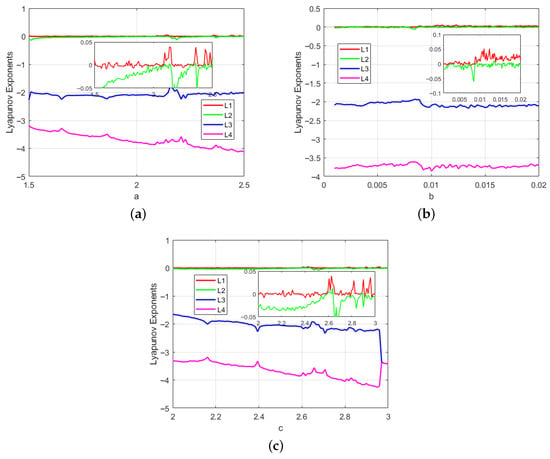
Figure 6.
Lyapunov exponents of the system for varying (a) a, (b) b, and (c) c values.
3.2.1. Lyapunov Dimension and Dynamical Transitions
We use the Kaplan–Yorke dimension for attractor complexity [].
Figure 7 and Figure 8 show broad plateaus near separated by narrow transition bands revealing alternating intervals of low-dimensional dynamics and higher-dimensional attractors.
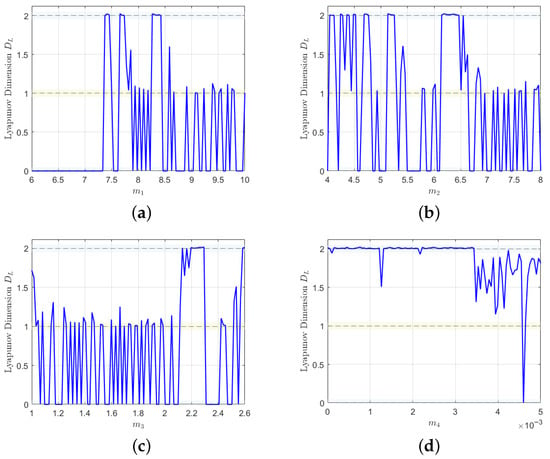
Figure 7.
Variation in the Lyapunov (Kaplan–Yorke) dimension as a function of feedback parameters: (a) , (b) , (c) , and (d) . The plots reveal alternating intervals of low-dimensional dynamics and higher-dimensional attractors.

Figure 8.
Variation in the Lyapunov (Kaplan–Yorke) dimension as a function of structural parameters: (a) a, (b) b, and (c) c.
Figure 9 illustrates the variation in the Lyapunov spectrum with respect to changes in each initial condition while keeping the other three fixed. In all cases, the largest exponent remains strictly positive, confirming the persistence of chaotic dynamics throughout the tested ranges of initial conditions. The second exponent remains close to zero, as expected for autonomous systems due to the neutral direction associated with the flow. The remaining exponents and are negative, indicating contraction along stable directions. The insets highlight the near-zero range, revealing small fluctuations in that suggest moderate sensitivity to perturbations in the initial state but no abrupt transitions in the underlying attractor. These results demonstrate that the system’s chaotic behaviour is robust to moderate variations in the starting conditions.
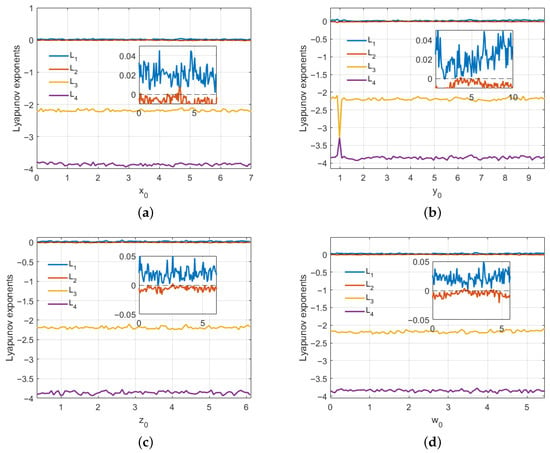
Figure 9.
Variation in the Lyapunov spectrum of the extended financial system with respect to (a) , (b) , (c) , and (d) while keeping the other three initial conditions fixed.
3.2.2. Dissipativity and Entropy
For smooth autonomous flows, the sum of Lyapunov exponents equals the long-time mean phase–space divergence along typical trajectories, . At our baseline, we obtain and (see the divergence trace in Figure 10), which agree within and are both negative, confirming dissipativity. Moreover, the Kolmogorov–Sinai entropy satisfies ; here, , indicating positive information production and thus chaotic dynamics.
3.2.3. Delay-Embedding
Using average mutual information, the first minimum occurs at (Figure 11a, left); the ACF crosses zero at a comparable lag (Figure 11a, right). The false-nearest-neighbours curve falls steeply and is by (Figure 11b), so we adopt . The 2D/3D reconstructions (Figure 11c,d) show a thin, folded manifold with stretching rather than a single closed curve, consistent with a low-dimensional deterministic attractor. Together with the positive largest Lyapunov exponent reported, these embeddings support the presence of chaotic dynamics.
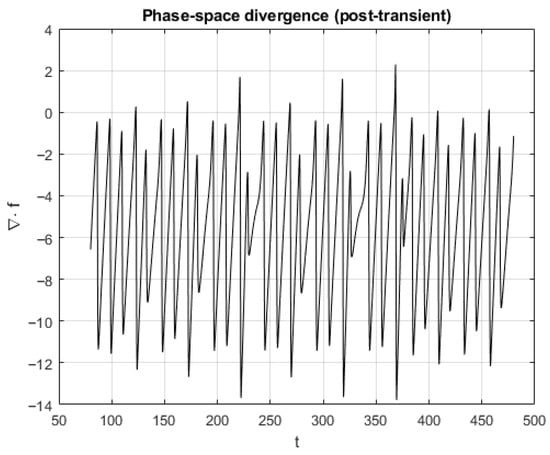
Figure 10.
Running time average of the phase–space divergence along the same trajectory. The long-time mean is . and, together with , confirms dissipativity and positive entropy production.
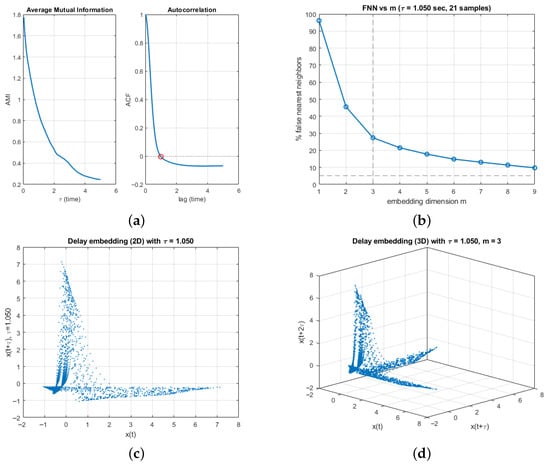
Figure 11.
Delay-embedding diagnostics and reconstructions for with optimal delay and embedding dimension : (a) Average mutual information (left) and autocorrelation (right) vs. lag; the first AMI minimum occurs at and the ACF crosses zero at a comparable lag. (b) False nearest neighbors (%) versus embedding dimension m; the rate drops below by . (c) 2D delay embedding . (d) 3D delay embedding .
3.3. Equilibrium and Stability Analysis
Because closed-form equilibria are not available when the confidence state is active (), we use numerical continuation. For each parameter , we sweep a grid of values and solve the steady-state system as follows:
with fsolve (seeding each step with the previous solution), and then evaluate the Jacobian J at the equilibrium . Local stability is assessed from the spectrum of J.
Figure 12 and Figure 13 show smooth changes in the equilibrium components across all sweeps, consistent with continuous parameter dependence. The stability panels reveal that, over the scanned ranges, at least one eigenvalue real part remains positive for essentially all settings, so the equilibrium is not locally asymptotically stable.
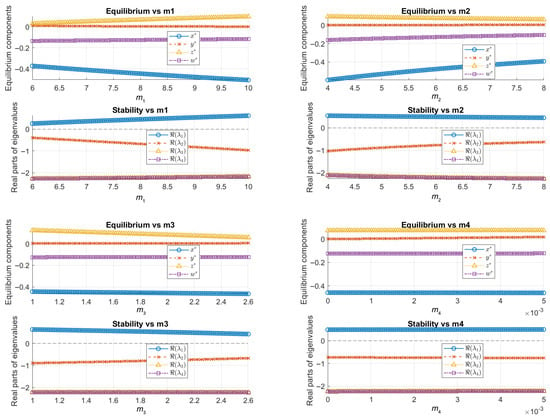
Figure 12.
Equilibrium and stability versus the feedback parameters . (Top): equilibrium components . (Bottom): real parts of the Jacobian eigenvalues at equilibrium. Persistent indicates an unstable equilibrium.

Figure 13.
Equilibrium and stability versus the structural parameters . (Top): equilibrium components. (Bottom): real parts of eigenvalues.
Consistent with the global diagnostics reported earlier, intervals where align with elevated Lyapunov complexity, supporting the interpretation that reflexive feedback maintains oscillatory/chaotic motion rather than convergence to a fixed point.
To illustrate these findings with a representative example, we examine the equilibrium structure at the baseline parameter values given in (3). At these settings, the system admits a non-trivial equilibrium point:
The Jacobian evaluated at reveals a pair of complex conjugate eigenvalues with positive real parts, indicating an unstable spiral–saddle configuration. This local instability is consistent with the global behaviour observed in the numerical simulations and bifurcation diagrams. Figure 14 presents the corresponding phase portraits, which display high-dimensional chaotic trajectories, further highlighting the active role of market confidence in driving instability.
When , the extended model reduces to the original three-dimensional chaotic financial system introduced by []. The bifurcation structure and stability of equilibria in that reduced model were thoroughly investigated in their work, including conditions for saddle-node and Hopf bifurcations. Their classification of strange attractors in the three-dimensional system supports the interpretation that chaos is already embedded in the core dynamics and is further enriched by introducing dynamic market confidence as a fourth state variable.
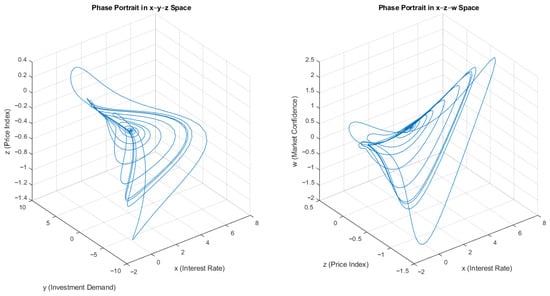
Figure 14.
Phase portraits of the extended financial system projected into (left) x–y–z space and (right) x–z–w space. The projections show complex, aperiodic motion, with market confidence acting as an active driver in system instability.
3.4. State Trajectories, Bifurcation Diagrams, and Phase Portraits
3.4.1. State Trajectories
Using the original parameter settings (3) and initial conditions, we simulated the system (2) over a time span of with a step size of , and plotted the state trajectories of all four variables to observe the emergence of chaotic behaviour.
The state trajectories generated from the initial condition with exhibit irregular, aperiodic behaviour, providing clear evidence of chaos in the system.
Figure 15 shows the state trajectories at baseline: and display bursting, has a sawtooth pattern with slow ramps and sharp drops, and oscillates irregularly with small amplitude around zero. These trajectories indicate chaos; even small confidence feedback generates complex, unpredictable motion.

Figure 15.
State trajectories of the state variables , , , and simulated from the initial condition with fixed parameter values from Equation (3). The irregular and non-repeating trajectories indicate chaotic behaviour in the system.
To assess the sensitivity of the system to initial conditions, we performed perturbation experiments in which small deviations were introduced to individual components of the nominal initial state . Three perturbed cases were considered: IC2 with , IC3 with , and IC4 with , while keeping the other components fixed at their nominal values. Figure 16 shows the resulting state trajectories for all four state variables over a simulation horizon of .
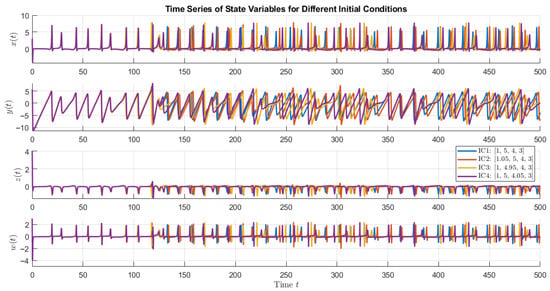
Figure 16.
State trajectories of all four state variables , , , and under small perturbations to the initial conditions. The nominal initial condition is . Perturbations of magnitude were applied to one component at a time, producing IC2: , IC3: , and IC4: , with all other components unchanged.
In each subplot, the initially close trajectories diverge markedly as time progresses, despite the perturbations being as small as . This rapid divergence indicates the presence of sensitive dependence on initial conditions, a hallmark of chaotic dynamics. Such behaviour implies that precise long-term prediction of the system’s state is practically impossible, even when initial measurements are highly accurate.
3.4.2. Phase Portraits
Figure 17 shows projections of the four-dimensional attractor onto several three-dimensional subspaces. In standard 2D/3D projections, the trajectories lie on thin, folded manifolds that are densely visited—typical of strange attractors—consistent with a positive largest Lyapunov exponent and the Kaplan–Yorke dimension estimates. As a geometric check, we estimated the correlation (Grassberger–Procaccia) dimension from long trajectories, obtaining over the scaling window (log–log indices ), in line with the Lyapunov- and Kaplan–Yorke-based evidence of low-dimensional chaos.
3.4.3. Bifurcation Analysis
Bifurcation diagrams were generated to examine how the system’s long-term dynamics evolve as key parameters are varied individually while keeping all others fixed at their baseline values (3). For each parameter sweep, the system was integrated for a total time of using the ode45 solver in Matlab with , relative tolerance , and absolute tolerance . The first 80% of each trajectory was discarded to eliminate transients, and the remaining steady-state portion was processed to extract peaks with a minimum prominence of , enabling clear identification of periodic and chaotic structures.
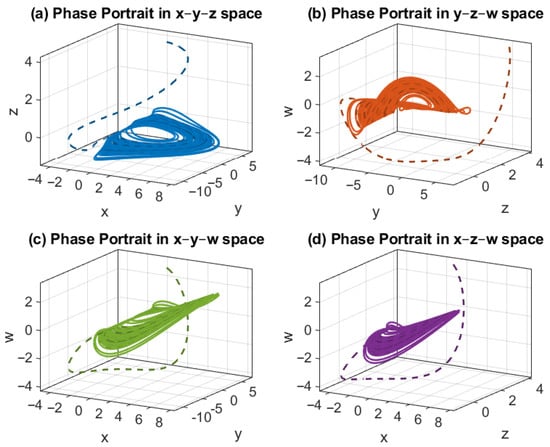
Figure 17.
Phase portraits of the extended financial system projected onto different 3D subspaces. The trajectories exhibit complex, aperiodic motion with folding and stretching, confirming chaotic dynamics. Projections involving the market confidence variable w emphasise its active role in destabilising the system.
For (see Figure 18), trajectories progress from stable fixed points through a period-doubling cascade into chaos, with intermittent periodic windows; irregularity is strongest in and , while remains lower in amplitude yet still fluctuates chaotically.
For (Figure 19), chaos begins near , persists in a broadband up to , then restabilises—indicating a feedback sensitivity threshold.
For (Figure 20), dynamics are periodic at small values, followed by an abrupt onset of chaos near .
For small positive (up to ) (Figure 21), strong irregularity appears across all variables, confirming the destabilising effect of self-feedback.
Varying structural parameters shows similar routes: for (Figure 22), chaos dominates for with occasional periodic windows; for (Figure 23), chaos emerges early and spans most of the range with only narrow periodic intervals; for (Figure 24), behaviour remains regular until about , beyond which chaos persists.
Overall, both confidence-related (–) and structural () parameters drive transitions from steady/periodic motion to chaos via period-doubling, punctuated by periodic windows, and the strength of chaotic signatures varies across state variables.
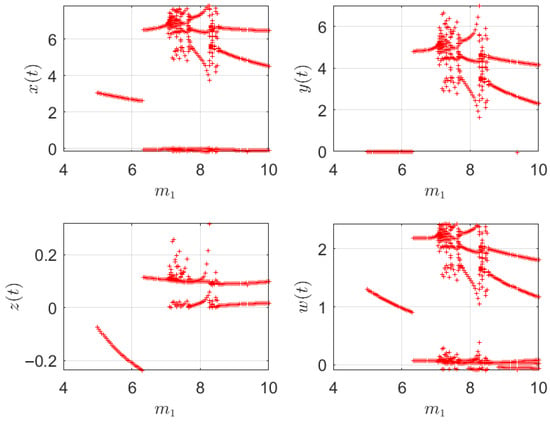
Figure 18.
Bifurcation diagrams of , , , and with respect to . The system transitions from periodic motion to chaos via period-doubling, with intermittent periodic windows.
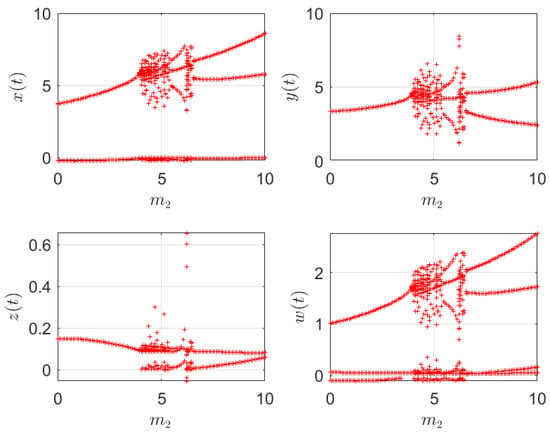
Figure 19.
Bifurcation diagrams of , , , and with respect to . A pronounced chaotic band emerges around before the system restabilises.

Figure 20.
Bifurcation diagrams of , , , and with respect to . Chaos emerges abruptly near .
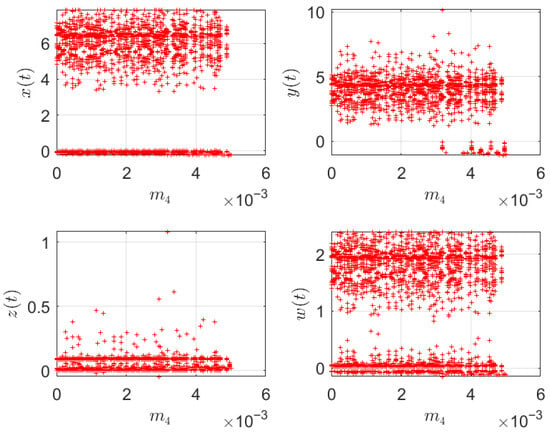
Figure 21.
Bifurcation diagrams of , , , and with respect to . Even small values induce chaotic motion.

Figure 22.
Bifurcation diagrams of , , , and with respect to a.
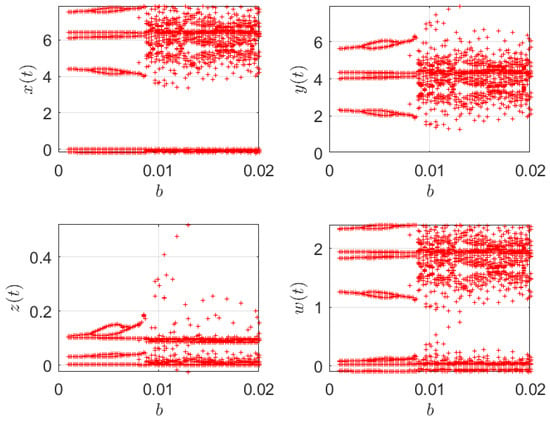
Figure 23.
Bifurcation diagrams of , , , and with respect to b.
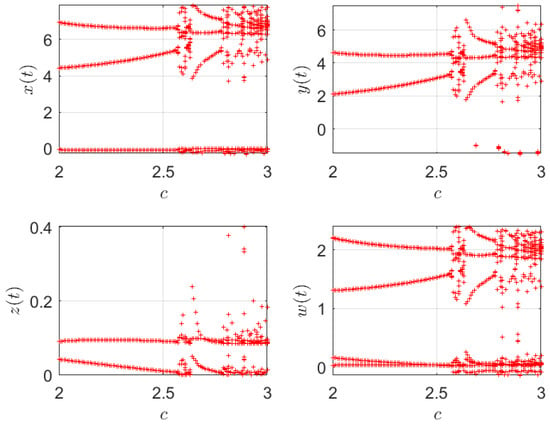
Figure 24.
Bifurcation diagrams of , , , and with respect to c.
3.5. Special Case Analysis of the Financial Model
To better understand the structure and dynamics of the proposed four-dimensional financial system, we consider several special cases by fixing one or more variables or initial conditions. Each case yields a reduced system that provides insight into specific economic scenarios.
Figure 25 presents the state trajectories of the system variables under six distinct special cases.
Case 1: (No Market Confidence Influence). Setting reduces the system to
This corresponds to the classical Ma–Chen system without sentiment effects. The variables , , and exhibit bounded oscillations and retain long-term stability. Economically, this represents a market driven solely by fundamental relationships between interest rates, investment demand, and price levels, with no influence from investor sentiment—a purely rational-expectations scenario.
Case 2: (Frozen Interest Rate). Fixing the interest rate gives
In this scenario, evolves exponentially, driving and upward without the moderating influence of interest rate adjustments. This is analogous to a fixed-monetary-policy regime during which credit expansion or inflation accelerates unchecked, resembling historical episodes where prolonged low interest rates contributed to asset bubbles.
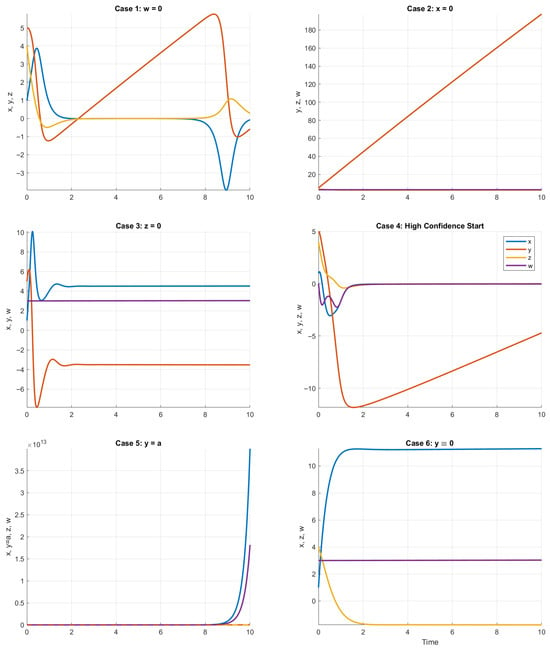
Figure 25.
State trajectories for all six special cases of the financial system.
Case 3: (Frozen Price Index). Assuming a constant price index yields
Here, inflationary effects are absent, and the remaining variables display damped nonlinear oscillations. This reflects an idealised economy with perfectly stable prices, where market adjustments occur through changes in interest rates and investment demand. Such conditions are rare in practice but can be compared to periods of price stability under effective inflation targeting.
Case 4: Large Initial w (Highly Confident Market). To examine the impact of extremely high market confidence, we simulate the full system (2) with a large initial value . The initial surge in confidence temporarily boosts , , and , but due to the small value, the system eventually returns to bounded oscillations. Economically, this reflects periods such as the peak of the dot-com bubble, where extreme optimism drove rapid market expansion before stabilising forces moderated growth.
Case 5: (Neutral Investment Threshold). Fixing gives the reduced system
Removing the dynamic feedback from investment demand disrupts stability, leading to unbounded growth in and . This scenario is analogous to credit booms or asset price bubbles where monetary and price variables escalate without corresponding productive investment, often precipitating systemic crises.
Case 6: (No Investment Demand). Assuming zero investment demand yields
Here, evolves exponentially, with producing sustained growth in confidence independent of real economic activity. This can destabilise the interest rate and price index through w’s coupling, despite the absence of productive investment. Such dynamics resemble stagflationary episodes, where high inflation and interest rates persist even during stagnant or contracting economic output.
In summary, Cases 1 and 3 are dynamically stable; Cases 2, 4, and 6 show sharp but bounded reactions; and Case 5 exhibits chaotic divergence. These results reveal the delicate interplay between interest rate, investment, inflation, and confidence in generating macroeconomic stability.
3.6. Empirical Illustration of a Self-Reinforcing Sentiment Loop
To complement the model-based analysis, we provide a compact empirical illustration using U.S. monthly data: the University of Michigan Consumer Sentiment Index (UMCSENT) and the S&P 500 index (SP500). Daily SP500 observations were averaged to month-end; both series were standardised to zero mean and unit variance (z–scores) to ease comparison.
Figure 26a overlays the two standardised series. Co-movement is evident around large episodes (rallies and drawdowns), while some intervals show divergence (e.g., rising prices alongside deteriorating sentiment). These patterns already suggest a dynamic two-way relation rather than a single leading indicator.
Figure 26b plots the phase trajectory (price on the vertical axis vs. sentiment on the horizontal axis) with one-step arrows. The trajectory forms local loops during pronounced episodes, which is characteristic of feedback: optimism and price appreciation reinforce each other in upswings, whereas pessimism and price declines reinforce each other in downswings.
Figure 26c estimates a reduced-form sentiment map via a cubic fit. The fitted curve lies above the line for moderately positive and below it for moderately negative , indicating local regions where deviations tend to persist in the same direction. Intersections with the line mark fixed points; the central crossing corresponds to a locally weakly stable region, whereas the curvature in the shoulders suggests amplification when the system is away from the centre. This pattern mirrors the self-feedback nonlinearity in our model.
Finally, Figure 26d reports lead–lag correlations for months, where denotes sentiment and denotes price (both as z–scores). The cross-correlogram is asymmetric: correlations are positive for with a peak around –8 months (price follows sentiment), and mostly negative for (price movements precede opposite-signed adjustments in sentiment). This asymmetry is consistent with a reflexive loop in which sentiment tends to lead medium-term price dynamics, while large prior price moves can subsequently weigh on household sentiment (e.g., via inflation or macro news). We emphasise that these are associations rather than causal estimates; nonetheless, the directionality is informative for the mechanism.

Figure 26.
Empirical illustration of a reflexive sentiment–price loop.
Overall, the four panels portray a coherent picture: noticeable co-movement in levels, looped phase trajectories during episodes, sentiment leading prices at medium horizons with an asymmetric cross-correlogram, and a nonlinear persistence map for sentiment. While not a causal test, these stylised facts are consistent with the model’s self-reinforcing confidence channel and justify our focus on diagnostics that capture persistence and amplification.
4. Discussion
Diagnostics consistently indicate low-dimensional chaos. The largest Lyapunov exponent is positive while the sum of exponents is negative (dissipative flow). The Kaplan–Yorke dimension varies non-monotonically within a narrow band (well below the system dimension), pointing to strange attractors with, at most, one positive exponent (chaotic). Broadband power spectra, multistrip Poincaré sections, and rapid separation of nearby trajectories corroborate sensitivity to initial conditions. The results show that the reflexive (confidence) channel has a clear, parameter-sensitive influence: it systematically shifts bifurcation onsets and accentuates intermittent windows in specific regions, while global chaos diagnostics (largest Lyapunov exponent and ) remain robust across broad settings.
Equilibria obtained under the scanned configurations are dynamically unstable, so trajectories do not settle to steady states; reflexive confidence feedback sustains oscillatory/chaotic motion. Parameter scans reveal period-doubling cascades with intermittent periodic windows. Confidence-related gains govern the onset and width of chaotic bands, while structural parameters shift thresholds; the strength of chaotic signatures is variable across state components, underscoring the need for a multivariate assessment rather than reliance on a single observable.
Special cases further clarify mechanism: fixing confidence or prices yields bounded dynamics, whereas fixing interest or suppressing investment, imposing large initial confidence, or enforcing neutral investment conditions can trigger explosive or chaotic responses. Overall, reflexive feedback reshapes long-run behaviour and acts as a destabilising amplifier, pushing the system into low-dimensional chaotic regimes under modest gains.
5. Conclusions
The reflexive extension produces a dissipative yet chaotic regime with no stable equilibria across broad parameter sets. Chaos is low-dimensional (one positive Lyapunov exponent) and is governed primarily by confidence gains and their coupling to real activity, while structural parameters shift critical thresholds. Evidence includes a positive largest Lyapunov exponent, a non-monotonic Kaplan–Yorke dimension well below the system dimension, unstable equilibria that preclude steady states, and parameter-induced transitions via period-doubling interlaced with periodic windows. The strength of chaotic signatures differs across state variables, underscoring the need for multivariate diagnostics rather than reliance on a single observable.
In our framework, volatility is interpreted in the dynamical sense: it manifests as irregular and aperiodic fluctuations in the interest rate, investment demand, and price index, driven by reflexive market confidence. This behaviour is quantified statistically by a positive largest Lyapunov exponent and supported by bifurcation diagrams showing alternating chaotic and periodic regimes. Hence, the model demonstrates that sentiment-driven feedback not only destabilises equilibria but also sustains volatility as an inherent feature of the system.
As an external validity check, the UMCSENT–S&P 500 pair exhibits looped phase paths and an asymmetric cross-correlogram with sentiment leading prices at 6–8 months; a cubic fit of on shows curvature consistent with local persistence. These stylised facts align with the model’s self-reinforcing confidence channel. The exercise is illustrative rather than causal, but it supports the mechanism we analyse theoretically.
For practical use and further study, control or feedback-damping strategies should be designed to suppress chaotic volatility under targeted conditions; extensions to stochastic or fractional-order dynamics may capture additional real-world features. From a policy perspective, chaotic windows expand when reflexive gains and investment–confidence coupling are high; measures that damp reflexivity (transparent, rules-based guidance; volatility breaks) and weaken the optimism–investment loop (countercyclical buffers, LTV/DTI and margin limits, leverage/liquidity rules) shift dynamics toward periodic or quasi-periodic regimes without materially altering long-run levels, acting on feedback gains rather than state magnitudes.
Future work will develop and benchmark a neural–fuzzy controller, and assess robustness to disturbances, measurement noise, and parameter drift. We will also examine integrability and possible invariants. In addition, we will study a fractional-order formulation, establish stability with fractional Lyapunov and Mittag–Leffler tools, implement L1 and Grünwald–Letnikov time-stepping schemes, and compare dynamics and control performance with the integer–order model.
Author Contributions
Conceptualisation, U.P.; methodology, U.P. and C.D.; software, U.P. and C.D.; validation, U.P. and C.D.; formal analysis, U.P. and C.D.; investigation, U.P. and C.D.; resources, U.P. and C.D.; data curation, U.P. and C.D.; writing—original draft preparation, C.D.; writing—review and editing, U.P. and C.D.; visualisation, U.P. and C.D.; supervision, U.P.; project administration, U.P. All authors have read and agreed to the published version of the manuscript.
Funding
This research is partially funded by the University of Kelaniya Research Council Grant number RP/03/02/04/02/2025.
Institutional Review Board Statement
Not applicable.
Informed Consent Statement
Not applicable.
Data Availability Statement
The MATLAB (R2019a) code and numerical data used to generate the results in this study are publicly available at the following GitHub repository: https://github.com/upeksha1/finance_system (accessed on 26 October 2025).
Conflicts of Interest
The authors declare no conflicts of interest.
Appendix A. Feasible Parameter Ranges
Figure A1 and Figure A2 report post-transient peak magnitudes of the state variables, , , , and , as each model parameter is varied with all others fixed at the baseline in (3). For each run, the first 80% of the trajectory is discarded as transient; an integration is flagged as divergent if exceeds the preset threshold (black “×” marks on the horizontal axis).
We call a parameter value feasible if the integration finishes without divergence and the steady-state peaks remain within numerically moderate bounds (i.e., no order-of-magnitude spikes in the log–scale plots). Applying this conservative criterion yields the workable subranges in Table A1. The intervals intentionally avoid narrow spike windows visible in the scans; other values may still be usable with different initial conditions or tighter solver tolerances.

Table A1.
Feasible parameter ranges implied by Figure A1 and Figure A2 (subset of the prior ranges in Table 1).
| Parameter | Feasible Range |
|---|---|
| a | |
| b | |
| c |
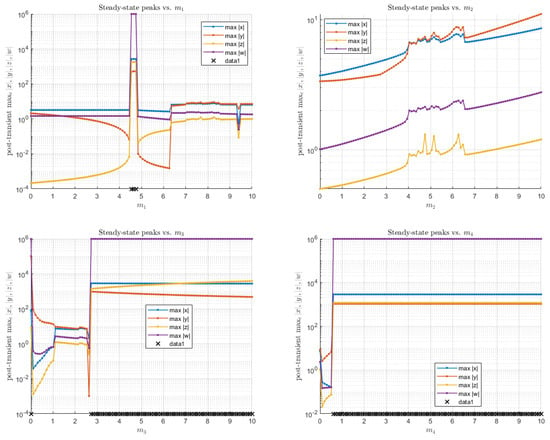
Figure A1.
Amplitude scans for confidence-related parameters. Each line shows the post-transient peak of , , , or at each grid point. Crosses (when present) mark early termination due to divergence.
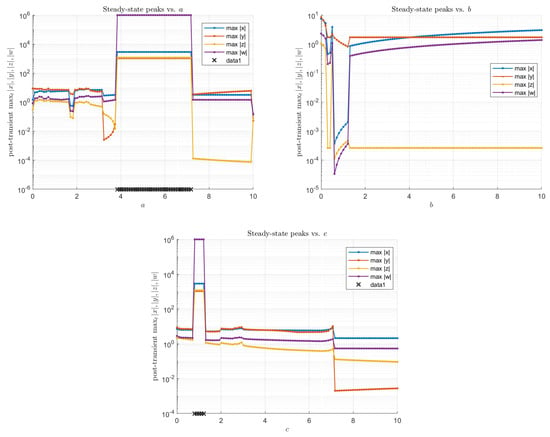
Figure A2.
Amplitude scans for structural parameters.
These intervals agree with the economic ranges in Table 1. For the reflexivity coefficient in particular, we adopt the conservative bound used in the simulations to avoid blow-up, which still lies comfortably inside the broader economically plausible range.
References
- Grandmont, J.M. On Endogenous Competitive Business Cycles. Econometrica 1985, 53, 995–1045. [Google Scholar] [CrossRef]
- Brock, W.A.; Hommes, C.H. A Rational Route to Randomness. Econometrica 1997, 65, 1059–1095. [Google Scholar] [CrossRef]
- Hommes, C.H. Heterogeneous Agent Models in Economics and Finance. In Handbook of Computational Economics; Judd, K.L., Tesfatsion, L., Eds.; Elsevier: Amsterdam, The Netherlands, 2006; Volume 2, pp. 1109–1186. [Google Scholar]
- Zhang, W.B. Discrete Dynamical Systems, Bifurcations and Chaos in Economics; Elsevier: Amsterdam, The Netherlands, 2006; Volume 204. [Google Scholar]
- Foroni, I.; Gardini, L. Homoclinic bifurcations in heterogeneous market models. Chaos Solitons Fractals 2003, 15, 743–760. [Google Scholar] [CrossRef]
- Mihailescu, E. Inverse limits and statistical properties for chaotic implicitly defined economic models. J. Math. Anal. Appl. 2012, 394, 517–528. [Google Scholar] [CrossRef]
- Ma, J.H.; Chen, Y.S. Study for the Bifurcation Topological Structure and the Global Complicated Character of a Kind of Non-linear Finance System (I). Appl. Math. Mech. 2001, 22, 1119–1128. [Google Scholar]
- Ma, J.H.; Chen, Y.S. Study for the Bifurcation Topological Structure and the Global Complicated Character of a Kind of Non-linear Finance System (II). Appl. Math. Mech. 2001, 22, 1236–1242. [Google Scholar]
- Xin, B.; Zhang, Q. Finite-Time Stability Analysis and Control Synthesis for a Financial System with Market Confidence. Nonlinear Dyn. 2015, 80, 1721–1731. [Google Scholar]
- Soros, G. Fallibility, reflexivity, and the human uncertainty principle. J. Econ. Methodol. 2013, 20, 309–329. [Google Scholar] [CrossRef]
- Filimonov, V.; Sornette, D. Quantifying Reflexivity in Financial Markets: Toward a Prediction of Flash Crashes. Phys. Rev. E 2012, 85, 056108. [Google Scholar] [CrossRef] [PubMed]
- Greenwood, R.; Hanson, S.G.; Jin, L.J. Reflexivity in Credit Markets; NBER Working Paper 25747; National Bureau of Economic Research: Cambridge, MA, USA, 2019. [Google Scholar] [CrossRef]
- Wyart, M.; Bouchaud, J.P. Self-Referential Behaviour, Overreaction and Conventions in Financial Markets. J. Econ. Behav. Organ. 2003, 63, 1–24. [Google Scholar] [CrossRef]
- Xin, B.; Zhang, J. Finite-time stabilizing a fractional-order chaotic financial system with market confidence. Nonlinear Dyn. 2015, 79, 1399–1409. [Google Scholar] [CrossRef]
- Akerlof, G.A.; Shiller, R.J. Animal Spirits: How Human Psychology Drives the Economy, and Why It Matters for Global Capitalism; Princeton University Press: Princeton, NJ, USA, 2009. [Google Scholar]
- Barsky, R.B.; Sims, E.R. Information, Animal Spirits, and the Meaning of Consumer Confidence. Am. Econ. Rev. 2012, 102, 1343–1377. [Google Scholar] [CrossRef]
- Bloom, N. The Impact of Uncertainty Shocks. Econometrica 2009, 77, 623–685. [Google Scholar] [CrossRef]
- Gennaioli, N.; Ma, Y.; Shleifer, A. Expectations and Investment. J. Financ. Econ. 2016, 122, 195–214. [Google Scholar] [CrossRef]
- Shiller, R.J. Why Do People Dislike Inflation? In NBER Macroeconomics Annual 1997; Bernanke, B.S., Rotemberg, J.J., Eds.; MIT Press: Cambridge, MA, USA, 1997; pp. 159–218. [Google Scholar]
- Mankiw, N.G.; Reis, R. Sticky Information versus Sticky Prices: A Proposal to Replace the New Keynesian Phillips Curve. Q. J. Econ. 2002, 117, 1295–1328. [Google Scholar] [CrossRef]
- Minsky, H.P. Stabilizing an Unstable Economy; McGraw–Hill: Columbus, OH, USA, 1986. [Google Scholar]
- Ott, E. Chaos in Dynamical Systems, 2nd ed.; Cambridge University Press: Cambridge, UK, 2002. [Google Scholar] [CrossRef]
- Kantz, H.; Schreiber, T. Nonlinear Time Series Analysis, 2nd ed.; Cambridge Nonlinear Science Series; Cambridge University Press: Cambridge, UK, 2004; Volume 7. [Google Scholar]
- Kaplan, J.L.; Yorke, J.A. Chaotic Behavior of Multidimensional Difference Equations. In Functional Differential Equations and Approximation of Fixed Points; Lecture Notes in Mathematics; Peitgen, H.O., Walter, H.O., Eds.; Springer: Berlin/Heidelberg, Gemrany, 1979; Volume 730, pp. 204–227. [Google Scholar] [CrossRef]
- Takens, F. Detecting strange attractors in turbulence. In Dynamical Systems and Turbulence, Warwick 1980; LectureNotes inMathematics; Rand, D., Young, L.S., Eds.; Springer: Berlin, Heidelberg, 1981; Volume 898, pp. 366–381. [Google Scholar] [CrossRef]
- Wolf, A.; Swift, J.B.; Swinney, H.L.; Vastano, J.A. Determining Lyapunov exponents from a time series. Phys. D Nonlinear Phenom. 1985, 16, 285–317. [Google Scholar] [CrossRef]
- Benettin, G.; Galgani, L.; Giorgilli, A.; Strelcyn, J.M. Lyapunov Characteristic Exponents for Smooth Dynamical Systems and for Hamiltonian Systems; A Method for Computing All of Them. Part 1: Theory. Meccanica 1980, 15, 9–20. [Google Scholar] [CrossRef]
- Benettin, G.; Galgani, L.; Giorgilli, A.; Strelcyn, J.M. Lyapunov Characteristic Exponents for Smooth Dynamical Systems and for Hamiltonian Systems; A Method for Computing All of Them. Part 2: Numerical Application. Meccanica 1980, 15, 21–30. [Google Scholar] [CrossRef]
Disclaimer/Publisher’s Note: The statements, opinions and data contained in all publications are solely those of the individual author(s) and contributor(s) and not of MDPI and/or the editor(s). MDPI and/or the editor(s) disclaim responsibility for any injury to people or property resulting from any ideas, methods, instructions or products referred to in the content. |
© 2025 by the authors. Licensee MDPI, Basel, Switzerland. This article is an open access article distributed under the terms and conditions of the Creative Commons Attribution (CC BY) license (https://creativecommons.org/licenses/by/4.0/).